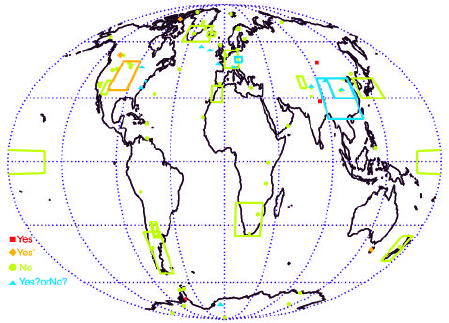Over at Hot Topic, I was challenged to:
Pick three of the “dissidents” from that list at random (roll a dice or summat). Read who they are - is this really an expert on the climate? Then read what they say. Read it carefully and critically, and if they give numbers cross-check them, and then check for rebuttals. If you tackle any of their work with the level of skepticism you’ve shown here you’ll find it illuminating.
So, I picked up a 41-sided die, rolled and the first number was 26.
26th on the list is in the section of people who “Believe global warming is primarily caused by natural processes”, right after Fred Singer:

Willie Soon, astrophysicist, Harvard-Smithsonian Center for Astrophysics: “there’s increasingly strong evidence that previous research conclusions, including those of the United Nations and the United States government concerning 20th century warming, may have been biased by underestimation of natural climate variations. The bottom line is that if these variations are indeed proven true, then, yes, natural climate fluctuations could be a dominant factor in the recent warming. In other words, natural factors could be more important than previously assumed.”
– from Global warming is not so hot: 1003 was worse, researchers find - Harvard University Gazette, April 2003
Ok, so it seems that this little known researcher hit the big news when his paper was attempted to be included, by the Bush administration, in an EPA report. The report seems to be meta-research; research of research. It purports to have examined around 200 different studies and shows that they all point towards warmer periods in the past. Indeed we can find the Center for Astrophysics press release, where the stated approach of this study was admirable;
Soon, Baliunas and colleagues analyzed numerous climate indicators including: borehole data; cultural data; glacier advances or retreats; geomorphology; isotopic analysis from lake sediments or ice cores, tree or peat celluloses (carbohydrates), corals, stalagmite or biological fossils; net ice accumulation rate, including dust or chemical counts; lake fossils and sediments; river sediments; melt layers in ice cores; phenological (recurring natural phenomena in relation to climate) and paleontological fossils; pollen; seafloor sediments; luminescent analysis; tree ring growth, including either ring width or maximum late-wood density; and shifting tree line positions plus tree stumps in lakes, marshes and streams. “Like forensic detectives, we assembled these series of clues in order to answer a specific question about local and regional climate change: Is there evidence for notable climatic anomalies during particular time periods over the past 1000 years?” Soon says. “The cumulative evidence showed that such anomalies did exist.”
Sounds good! This is actually a position I’m quite sympathetic with; reference to the periods of data which extend before the Renaissance, before modern scientists were there to make properly objective measurements. Times when vikings were crowing crops in Greenland, that sort of thing.
Anyway. Again there is much fuss made about some 5% funding of the research from the American Petroleum Institute. The other 95% came from the US government. Again we see claims that these people have been hired by the petroleum industry to consult. But then, so what. I’ve been paid by JP Morgan and KPMG before.
It seems after the paper hit the limelight the publisher of the journal disowned it, saying that “the reviewers failed to detect methodological flaws”. A skeptic’s favourite taunt, the hockey stick man Michael Mann said “this study was considered not even worthy of a response” (a funny thing to say of a $1m study collating so much research), while he does make reference to the study actually being torn down. So, perhaps we can find that.
Ok. So, according to this article by Richard Monastersky, there were 13 scientists who got together to rebutt it, and that the primary grounds for concern were;
They first took issue with how Mr. Soon and Ms. Baliunas defined evidence for a Medieval Warm Period: as any 50-year period of warmth, wetness, or drought between the years 800 and 1300.
Also;
Under their method, warmth in China in 850, drought in Africa in 1000, and> wet conditions in England in 1200 all would qualify as part of> the Medieval Warm Period, even though they happened centuries> apart.
Indeed. On page 10 of the paper, you’ll see (emphasis mine):
Was there a 50-year or longer period of sustained colder, wetter, or drier than average climate during the 1300 - 1900 period known as the Little Ice Age?
Was there a 50-year or longer period of sustained warmer, drier, or wetter than average climate during the 800 - 1300 period known as the Medieval Warm Period?
Is there a 50-year period in the proxy record that is warmer than the 20th century?
And this allows them to write on page 12:
One hundred twelve studies contained information about the Medieval Warm Period. Of these, 103 showed evidence for the Medieval Warm Period, 2 did not, and 7 had equivocal answers. Looking just at the Southern Hemisphere, we found 22 studies, 21 of which showed evidence of a Medieval Warm Period and one which did not.

Areas which had a 50-year or longer period which might possibly have been warmer than the myopic results they revealed for the 20th century, if you squinted at the right angle. Or something like that.
I’m strangely inclined to agree with Mann on the quality of the paper. It boggles why they simply didn’t alter the criteria to be more restrictive, so that the result could be credible. It’s a shame, because I think that a possibly interesting result in there - that 83 of 102 studies showed that there were 50-year or longer periods which were hotter than present day - can be ignored as well, especially given their definition. Mind you, for the timescales and accuracies of the proxy data they are using to reconstruct this history, you’d wonder whether this result was actually anything more than just noise. And the “warmer than the 20th Century” bit is really just a bit sloppy.
And what an interesting related find: historical context of the report, showing the vast amount of funding from ExxonMobil that was going into reports such as this. I try not to find people guilty by association, but … wow, what a lot of money those guys were pumping into the industry at that time.
Ok. I’ll cede that this paper is complete rubbish. That’s one black mark for the list. Now, proceed to the next.